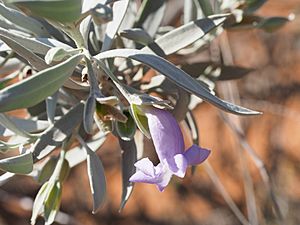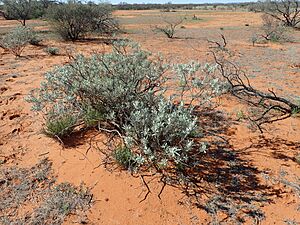Eremophila recurva facts for kids
Quick facts for kids Eremophila recurva |
|
|---|---|
 |
|
| Eremophila recurva leaves and flower | |
| Scientific classification | |
| Genus: |
Eremophila (plant)
|
| Species: |
recurva
|
Eremophila recurva is a beautiful flowering plant that belongs to the figwort family. This plant is special because it is found only in Australia. It grows as a bush with soft, hairy grey leaves, large grey parts called sepals, and pretty blue, mauve, or lilac flowers.
Contents
What it Looks Like
Eremophila recurva is a straight-growing bush that usually reaches about 0.5 to 1.8 meters (about 1.6 to 5.9 feet) tall. Its branches and leaves are covered in thick, soft, grey or yellowish hairs, making them feel like felt.
The leaves grow one after another along the stem, and many are grouped together at the ends of the branches. They are long and narrow, like a spearhead, usually about 3.2 to 5.7 centimeters (about 1.2 to 2.2 inches) long and 0.35 to 0.7 centimeters (about 0.1 to 0.2 inches) wide.
Flowers and Fruits
The flowers grow alone or in small groups of up to three, right where a leaf meets the stem. They sit on hairy stalks that are about 0.7 to 1.6 centimeters (about 0.2 to 0.6 inches) long.
Each flower has five sepals, which are like small leaves that protect the flower bud. These sepals are pale green to cream or purplish, about 0.5 to 1 centimeter (about 0.2 to 0.3 inches) long, and covered in hairs.
The petals, which are the colorful parts of the flower, are about 2 to 3 centimeters (about 0.7 to 1.1 inches) long. They are joined together at the bottom to form a tube. The outside of this tube is lilac, mauve, or violet, while the inside is cream-colored with light lilac spots. The outside of the tube is smooth, but the inside is full of soft, woolly hairs.
Inside the petal tube are four stamens, which are the parts that produce pollen. These stamens are completely hidden inside the tube.
Eremophila recurva flowers from May to September. After the flowers, it produces fruits that are oval to cone-shaped, about 0.7 to 1.1 centimeters (about 0.2 to 0.4 inches) long, with a pointed end and a papery covering.

How it was Named
This plant was first officially described by a scientist named Robert Chinnock in 2007. He published his description in a book called Eremophila and Allied Genera: A Monograph of the Plant Family Myoporaceae.
The second part of its scientific name, recurva, comes from a Latin word that means "bent backwards." This refers to how the edges of the sepals (the protective parts around the flower) often curve under.
Where it Grows
Eremophila recurva is found in Western Australia, specifically between Gascoyne Junction and Dairy Creek to the east. It grows in areas with red sand, either on flat plains or on stony ground.
Conservation Status
The Western Australian Government's Department of Parks and Wildlife has classified Eremophila recurva as "not threatened." This means that, for now, there are enough of these plants in the wild, and they are not in danger of disappearing.
How People Use it
People like to grow Eremophila recurva in gardens because of its pretty silvery-grey leaves and its lovely lilac-colored flowers. It's a compact bush, meaning it doesn't grow too big.
You can grow new plants from cuttings, which are small pieces taken from an existing plant. However, most of the plants grown in gardens are made by grafting. This is a special method where a piece of Eremophila recurva is joined onto the root system of another plant called Myoporum.
This plant grows best in soil that drains water well and in a spot that gets lots of sun. It doesn't need much water, only a little during very long dry periods. It can also handle light to moderate frosts.

